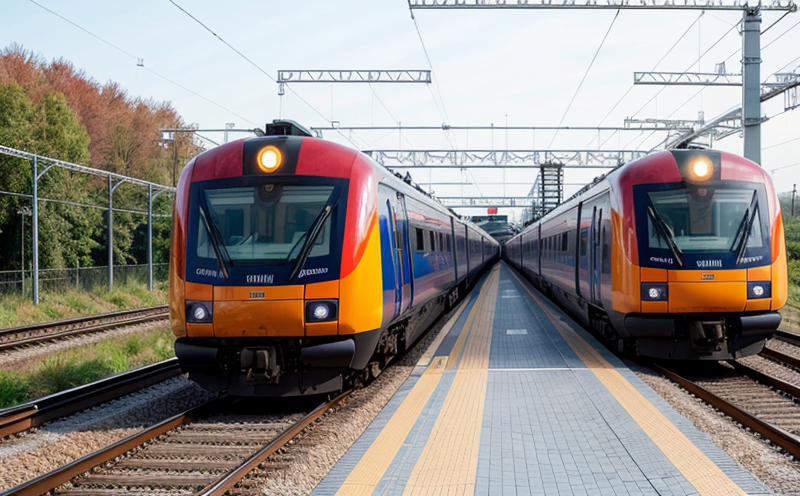EN 16407 Passenger Comfort Testing via Smart Sensors
The European Standard EN 16407 is a cornerstone in the development and validation of smart railway systems aimed at enhancing passenger comfort. This standard mandates rigorous testing to ensure that railway vehicles meet specific criteria regarding the comfort experienced by passengers during travel. The application of smart sensors allows for real-time data collection, analysis, and reporting on various parameters that contribute to passenger well-being.
Smart sensors play a crucial role in monitoring seat vibration, acceleration, noise levels, temperature fluctuations, and air quality within railway carriages. These parameters are critical as they directly impact the overall riding experience. By employing advanced sensor technology, testing laboratories can gather accurate data on how these factors affect passenger comfort, leading to more comfortable and efficient travel environments.
The testing process under EN 16407 involves multiple stages, each designed to evaluate different aspects of passenger comfort:
- Initial Setup: Calibration of smart sensors within the railway carriage ensures accurate data collection from the onset. This step is crucial as any discrepancies in calibration can lead to inaccurate results.
- Data Collection: Smart sensors are strategically placed throughout the carriage, capturing real-time data on various parameters such as noise levels and seat vibration. The extensive network of sensors allows for comprehensive monitoring across different sections of the train.
- Analytical Analysis: Collected data is then analyzed using advanced software tools to identify trends and patterns that may indicate areas requiring improvement in passenger comfort.
- Reporting: A detailed report summarizing all findings is provided. This document serves as a comprehensive guide for manufacturers, operators, and regulatory bodies, highlighting strengths and weaknesses within the railway system.
The implementation of smart sensors under EN 16407 is not only beneficial for enhancing passenger comfort but also plays a significant role in improving overall safety standards within the railway sector. By continuously monitoring these critical parameters, potential issues can be identified early on, allowing for timely interventions to prevent accidents or discomfort.
It's important to note that compliance with EN 16407 is increasingly becoming mandatory across Europe, reflecting growing emphasis on passenger well-being and safety in public transportation systems. Compliance ensures that railway vehicles adhere strictly to the highest standards of comfort and reliability as specified by this European standard.
Applied Standards
The application of EN 16407 involves several key aspects that are critical for ensuring passenger comfort in smart railway systems:
- EN 16407:2018: This European standard focuses on the testing and evaluation of passenger comfort in railway vehicles using smart sensor technology.
- ISO 9613-1:2015: This international standard provides guidance on measuring sound levels, which is a crucial parameter for assessing noise pollution within railway carriages under EN 16407.
- IEC 61852-1: Relevant for the calibration and performance of smart sensors used in passenger comfort testing.
- ASTM E396-19: Pertains to the measurement of mechanical properties using vibration tests, which is applicable when assessing seat vibration under EN 16407.
The combination of these standards ensures a robust and comprehensive approach to evaluating passenger comfort in railway vehicles. Compliance with these standards helps guarantee that testing procedures are consistent, reliable, and accurate across different environments and applications.
Benefits
The benefits of implementing EN 16407 Passenger Comfort Testing via Smart Sensors extend beyond mere compliance; they offer substantial advantages to various stakeholders involved in the railway sector:
- Enhanced Passenger Experience: By adhering strictly to this European standard, railway operators can significantly improve passenger comfort. This leads to increased customer satisfaction and loyalty.
- Improved Safety Standards: Continuous monitoring of critical parameters helps identify potential risks early on, thereby enhancing overall safety within the railway system.
- Cost Efficiency: Early detection of issues through regular testing can prevent costly repairs down the line. This proactive approach ensures that maintenance is carried out only when necessary.
- Innovation and Development: The use of smart sensors opens up possibilities for innovative solutions in railway design, leading to more advanced and efficient systems.
- Regulatory Compliance: Ensuring compliance with EN 16407 helps operators meet regulatory requirements set by various authorities, avoiding potential penalties or fines.
- Environmental Sustainability: By optimizing energy usage based on real-time data collected through smart sensors, railways can contribute to environmental sustainability efforts.
- Increased Efficiency: The ability to monitor and adjust parameters in real-time improves the overall efficiency of railway operations.
- International Recognition: Adherence to international standards like EN 16407 enhances a company’s reputation and marketability on a global scale.
These benefits underscore why adherence to EN 16407 is not just beneficial but essential for quality managers, compliance officers, R&D engineers, and procurement teams working within the railway sector. The standard ensures that passenger comfort is prioritized, contributing to a safer, more efficient, and sustainable transport system.
International Acceptance and Recognition
The acceptance and recognition of EN 16407 have grown significantly since its implementation in 2018. This European standard is widely recognized for its role in enhancing passenger comfort within smart railway systems, making it a key requirement for compliance by industry players.
Regulatory bodies across Europe have begun mandating the use of EN 16407, ensuring that all new and refurbished railway vehicles meet specified comfort standards. This move towards standardized testing procedures has been praised for its effectiveness in improving overall safety and passenger satisfaction within the sector.
The international community has also shown interest in adopting similar standards, recognizing the value of implementing such rigorous testing protocols. Organizations like the International Organization for Standardization (ISO) have highlighted EN 16407 as a model for future developments in railway comfort testing.
Manufacturers and operators who comply with EN 16407 can expect to see increased trust from passengers, improved operational efficiency, and enhanced reputation. The standard has become an industry benchmark, ensuring that only the highest quality systems are deployed across Europe.





